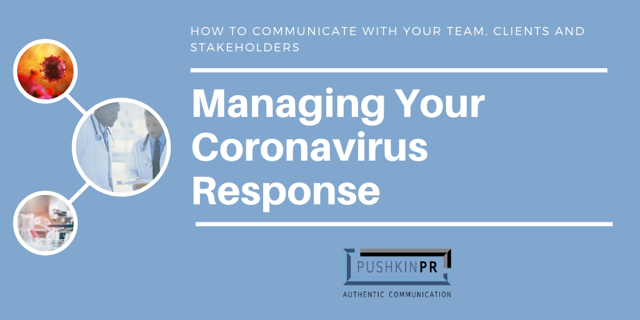
Managing Your Coronavirus Responses
Colorado’s first case of COVID-19 (novel coronavirus) has been reported. Many areas of life from religious traditions to social customs to global events will be impacted as the virus spreads. While the virus presents significant health risks, it also presents challenges for many business owners.
Businesses are likely to feel the impact on their bottom line as it becomes necessary for workers and clients to self-isolate or be put under quarantine. In a crisis communications situation like this, communications strategies are more important than ever. During times of crisis, maintaining a calm, collected brand voice and keeping open channels of communication with clients, team members and stakeholders is critical.
In order to prepare your company and ensure the safety of your team and clients to the best of your ability, we are recommending all of our clients take the following steps.
Ensure your crisis communications plan is up-to-date.
Now is the time to dust off your crisis communications plan and host a meeting with your team to review it. With a crisis of this nature, it is especially important to ensure that you have a clear chain of command detailed in your crisis plan, with backup options to account for the potential that key decision makers may be sick and unable to participate in decision making.
Items that should be included in your crisis communications plan:
- Chain of command for decision making related to closures
- Chain of command for fielding media inquiries
- Phone numbers for all team members and key stakeholders
- Phone numbers for your local health department
- Holding statements for addressing coronavirus exposure
- Work-from-home policies
In this plan, it is also a good idea to include information about how work will proceed in the event that employees are not able to come into the office and must work remotely due to quarantine procedures. Having your work-from-home policy for times of crisis clearly laid out in your crisis communications plan will help reduce confusion and the potential of an infected employee coming to work.
Finally, be sure to update your holding statements to include messaging addressing coronavirus. If your organization is directly impacted by coronavirus or an employee or client becomes ill, time will be of the essence. Having statements prepared will allow you to move as quickly as possible to share information with key stakeholders.
If you do not have a crisis communications plan prepared, contact us immediately and we can help you draft one.
Communicate your plan internally and cross-train spokespeople
After you have updated your crisis communications plan, it’s time to run through potential scenarios and make sure that all key team members are aware of the role they will play should you need to activate the plan.
Given the likelihood that at least one member of your team will be impacted by the virus, whether infected themselves or unable to work as they care for a sick loved one, it is critical to cross-train employees to execute the plan and serve as spokespeople. We recommend our clients hold a quick 15-minute meeting each day to review key roles, new developments and responsibilities, as they may change quickly in this rapidly evolving situation.
To ensure that your organization does not spread any misinformation, it is important to clarify your media policy with your entire team and clearly identify which of your employees are authorized to act as spokespeople and make sure all team members know who to refer media inquiries to.
Create a dedicated webpage for coronavirus related updates
In a quickly moving situation, having a centralized location where updates and the latest information can be compiled is key to avoiding confusion. Many organizations have already created landing pages dedicated to providing information about the coronavirus and their mitigation efforts.
We recommend that clients place a link to this dedicated page on the homepage of their website. Key information to include on the page:
- Information about whether or not any of your employees or locations have been exposed to the virus. While you should not identify employees, it is important to communicate whether there are any active or monitored cases tied to your organization or facilities.
- Details about your contingency plans. If you serve clients in-person, include information about whether your locations are open or not and how you will or will not serve clients if you close.
- Preventative measures that are underway. If your organization is encouraging employees to work from home, reduce nonessential travel, implement additional cleaning procedures or take any other precautions to minimize the risk of exposure, share these details.
- Links to external resources like the Centers for Disease Control (CDC) website and World Health Organization website
- A statement that the webpage reflects the situation as it currently stands and as this is a rapidly evolving situation, your organization will continue to evaluate the best course of action and update the page with the latest information as it is available.
- Contact information for your primary media spokesperson and leadership team member overseeing coronavirus preparedness.
Identify the best channels to communicate your response externally
Given the rapid spread of the virus and the likelihood that a majority of organizations will be impacted in one way or another, we recommend that all organizations begin communicating with clients and external stakeholders about their preparedness.
The purpose of such communications is to reassure your clients that you are aware of the severity of the situation and have contingency plans in place to address the situation, should your organization be directly impacted.
Email newsletters and social media offer effective ways to communicate these messages. While you don’t need to share the entirety of your crisis plan publicly, we recommend including the following items:
- A statement about how you are prioritizing employee and client safety and will continue to closely monitor the situation
- Details about preventative measures that are underway within your organization
- A link to the webpage mentioned above where clients can find the latest information about your response
Communicate with employees early and often
No matter where you are located in the world, if you have not already communicated with your employees about your plans to respond to the coronavirus, you are behind. Communicating early and thoroughly can help reduce panic and anxiety among your workforce.
While you may still be finalizing details like compensation if employees are unable to come to work or whether or not to close your office, it is important to let your team know that you are working on a plan to address these concerns.
Internal communications should include the following:
- A message that your organization is aware of the situation and making contingency plans to limit the disruption to business
- Information about precautionary measures that are being taken, such as restricting nonessential travel, canceling events or sanitizing common spaces.
- Unbiased, fact-based resources that employees can turn to for additional information like the Centers for Disease Control (CDC) website and World Health Organization website
- A specific point of contact for questions.
For help with Corona Virus, crisis communications contact Pushkin PR to help your brand.
Call us at 303-733-3441 or email us at info@pushkinpr.com
